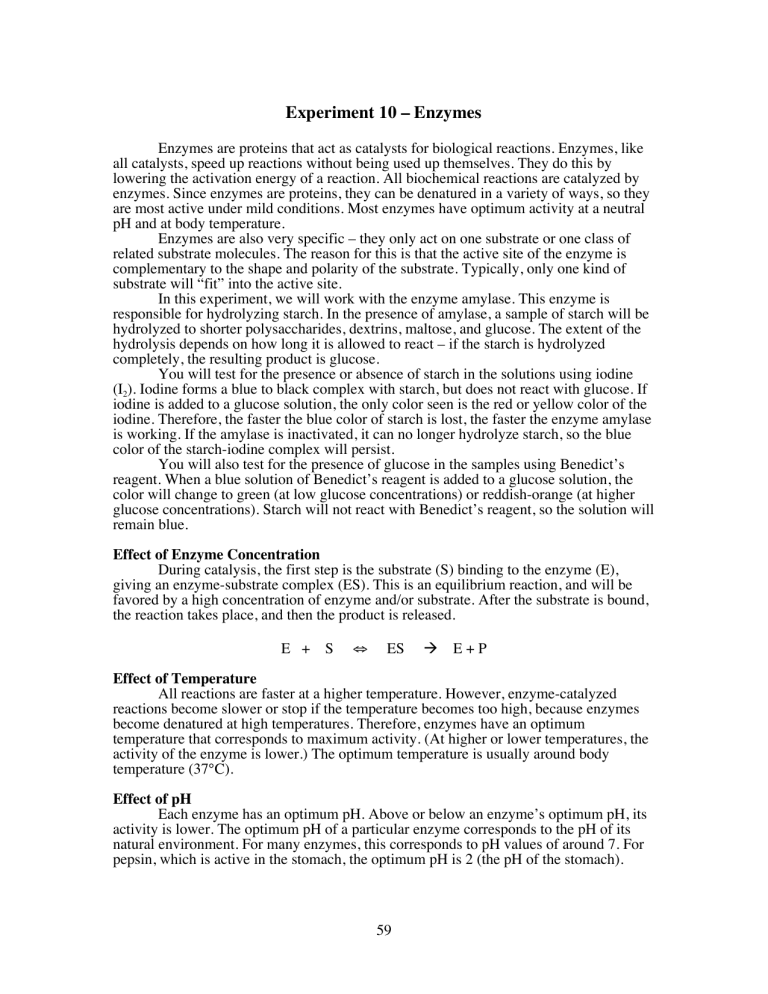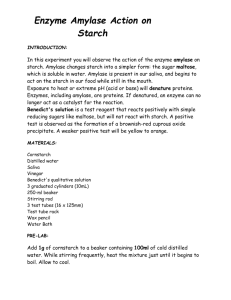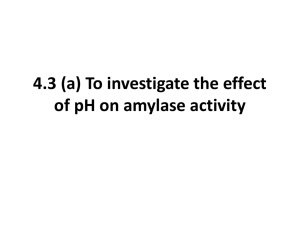
Experiment 10 – Enzymes Enzymes are proteins that act as catalysts for biological reactions. Enzymes, like all catalysts, speed up reactions without being used up themselves. They do this by lowering the activation energy of a reaction. All biochemical reactions are catalyzed by enzymes. Since enzymes are proteins, they can be denatured in a variety of ways, so they are most active under mild conditions. Most enzymes have optimum activity at a neutral pH and at body temperature. Enzymes are also very specific – they only act on one substrate or one class of related substrate molecules. The reason for this is that the active site of the enzyme is complementary to the shape and polarity of the substrate. Typically, only one kind of substrate will “fit” into the active site. In this experiment, we will work with the enzyme amylase. This enzyme is responsible for hydrolyzing starch. In the presence of amylase, a sample of starch will be hydrolyzed to shorter polysaccharides, dextrins, maltose, and glucose. The extent of the hydrolysis depends on how long it is allowed to react – if the starch is hydrolyzed completely, the resulting product is glucose. You will test for the presence or absence of starch in the solutions using iodine (I2). Iodine forms a blue to black complex with starch, but does not react with glucose. If iodine is added to a glucose solution, the only color seen is the red or yellow color of the iodine. Therefore, the faster the blue color of starch is lost, the faster the enzyme amylase is working. If the amylase is inactivated, it can no longer hydrolyze starch, so the blue color of the starch-iodine complex will persist. You will also test for the presence of glucose in the samples using Benedict’s reagent. When a blue solution of Benedict’s reagent is added to a glucose solution, the color will change to green (at low glucose concentrations) or reddish-orange (at higher glucose concentrations). Starch will not react with Benedict’s reagent, so the solution will remain blue. Effect of Enzyme Concentration During catalysis, the first step is the substrate (S) binding to the enzyme (E), giving an enzyme-substrate complex (ES). This is an equilibrium reaction, and will be favored by a high concentration of enzyme and/or substrate. After the substrate is bound, the reaction takes place, and then the product is released. E + S ⇔ ES à E+P Effect of Temperature All reactions are faster at a higher temperature. However, enzyme-catalyzed reactions become slower or stop if the temperature becomes too high, because enzymes become denatured at high temperatures. Therefore, enzymes have an optimum temperature that corresponds to maximum activity. (At higher or lower temperatures, the activity of the enzyme is lower.) The optimum temperature is usually around body temperature (37°C). Effect of pH Each enzyme has an optimum pH. Above or below an enzyme’s optimum pH, its activity is lower. The optimum pH of a particular enzyme corresponds to the pH of its natural environment. For many enzymes, this corresponds to pH values of around 7. For pepsin, which is active in the stomach, the optimum pH is 2 (the pH of the stomach). 59 Trypsin, which is active in the small intestine, has an optimum pH of 8 that matches the pH of the small intestine. Effect of Inhibitors Inhibitors are substances that slow down or stop enzymes. Competitive inhibitors are molecules that are very similar to the substrate, so they can bind to the enzyme but cannot react. They compete with the substrate for the active site of the enzyme. Noncompetitive inhibitors are molecules that are not similar to the substrate and therefore do not bind to the active site. They do, however, bind to a different location on the enzyme and change the shape of the active site so that the substrate can no longer bind. Irreversible inhibitors form covalent bonds to the enzyme and therefore cannot be removed. Safety Precautions: • Wear your safety goggles. Waste Disposal: • All waste must be placed in the inorganic waste containers (which have a blue label) in one of the fume hoods. Procedure Important: read the entire procedure and make sure you understand it before you start this experiment. Before you start each part of the experiment, make sure you will have enough time to complete it. Advance planning is very important for this experiment. Preparation: Constant temperature water baths will be needed for this experiment. The laboratory has a large water bath that can be set to 37°C, and everyone will use this water bath. You will also need a low temperature and a high temperature water bath, and you can make your own. For the low temperature bath, use a 250-mL or 400-mL beaker, fill it about halfway with tap water, and add some ice to the water. The temperature of this bath when it comes to constant temperature should be between 0 and 5°C. To make the high temperature water bath, fill a 250-mL or 400-mL beaker about two-thirds full and heat it until it boils. (You can heat it on a hotplate or on a Bunsen burner.) When it boils, you can reduce the heat, but keep it boiling. The temperature of this bath should be close to 100°C. You will need some 1% starch solution for each part of the experiment. Shake up the bottle of starch, and collect about 50 mL of the solution in a small beaker. You will also need some of the iodine reagent for each part of the experiment. If dropper bottles of the iodine reagent are available, obtain one of them. If there are no dropper bottles, collect a small amount of this reagent (about 3-5 mL) in a small beaker, 60 and get a clean dropper that you will only use for this iodine solution (to avoid contamination). You can prepare your own fresh amylase solution by collecting about 1-2 mL of your own saliva in a small beaker. (You will need to spit politely into the beaker.) After you have collected 1-2 mL of saliva, add about 50 mL of water to the saliva and mix well. For health reasons, you should work with your own saliva solution (not someone else’s). If a commercial amylase solution is available, you may use it instead of saliva. Collect about 40 mL of the solution in a small beaker. You will also need a white spot plate and some clean droppers. It is important that you rinse a dropper well with deionized water before using it on a new solution to avoid contamination. If remnants of one solution on a dropper are accidentally transferred to a different solution, your tests will be inconclusive. Reference tests: Test for starch Transfer a few drops of starch to one of the wells in the spot plate. Add one drop of the iodine reagent. Starch and iodine should react to give a deep blue-black complex. Test for glucose Place 3 mL of 1% glucose solution in a test tube. Add 2 mL of Benedict’s solution and heat for 3-4 minutes in a boiling water bath. The reaction should produce a red-orange solid. We will be using visual tests to evaluate the activity of the enzyme in each part of the experiment. You will collect samples of the enzyme-starch mixture at different times and add a drop of iodine reagent to each sample. The resulting color will tell you roughly how much starch has been hydrolyzed. When the enzyme activity is high, it won’t take very much time to hydrolyze the starch. When the enzyme is slowed down or is inactive, the blue-black color will be seen for a longer time. You can assess the relative enzyme activity as follows: Iodine test for starch Dark blue-black Blue Light brown Gold Amount of starch remaining All Most Some None Enzyme activity level None (0) Low (1) Moderate (2) High (3) Part 1: Effect of Enzyme Concentration 1. 2. Label five test tubes 1-5. Place 4 mL of 1 % starch in each of the first four test tubes. Place 4 mL of amylase solution in the fifth tube. Place all of the tubes in the 37°C water bath for 5 minutes. Obtain 5 clean droppers and label them 1-5. (To avoid contamination of these solutions, you will use a separate dropper for each mixture.) Tube 1 will be your control and it will not contain any enzyme. Remove the tubes from the water bath momentarily, and quickly add 3 drops of the warmed amylase solution to tube 2, add 6 drops amylase to tube 3, and add 10 drops amylase to tube 4. Mix the tubes quickly by shaking them gently, and immediately put them 61 3. 4. 5. 6. 7. back in the 37°C water bath. Record the time at which you added enzyme. Go on immediately to the next step. Transfer four drops of each reaction mixture (tubes 1-4) using a separate clean dropper for each to separate wells on a spot plate. (Keep the test tubes in the water bath.) Add one drop of the iodine reagent to each. Record your observations. Use the visual color reference table to assess the enzyme activity. After you have recorded your observations, rinse off the spot plate. Repeat step 3 after the mixtures have had five minutes of reaction time. Repeat step 3 after the mixtures have had ten minutes of reaction time. In the test tubes where hydrolysis occurred, the presence of glucose can be confirmed with Benedict’s reagent. Add 3 mL of Benedict’s reagent to each test tube and put them in the boiling water bath for 3-4 minutes. The appearance of a green to orange or red precipitate indicates the presence of glucose. If the solution remains blue with no solid, then no glucose is present and no hydrolysis of the starch has taken place. Make a graph of the enzyme activity vs. the amount of amylase solution using your results at 10 minutes. Part 2: Effect of Temperature 8. 9. 10. 11. 12. 13. 14. Place 4 mL of 1 % starch solution in each of three clean test tubes. Place 4 mL of amylase solution in 3 separate clean test tubes (so you will have a total of six test tubes: 3 containing starch and 3 containing enzyme). Place a starch tube and an amylase tube in the 37°C water bath. Place one tube of each in an ice-water bath, and one of each tube in a boiling water bath. Keep the tubes in their baths for 10 minutes to allow them to reach the temperature of their baths. Read and record the temperature of the ice-water bath. Pour the amylase solution into the starch solution, mix, and put the tube back into the bath. Record the time. Repeat step 10 for the 37°C bath. Repeat step 10 for the boiling water bath. For each mixture, after 10 minutes of reaction have elapsed, transfer 4 drops of the mixture to a spot plate. Add 1 drop of iodine reagent to each sample. Record the color and activity level of the enzyme in each case. Graph the enzyme activity level vs. temperature. Part 3: Effect of pH 15. 16. 17. 18. Label four test tubes pH 2, 4, 7, and 10. In each tube, place 4 mL of the appropriate buffer (with the corresponding pH). Add 4 mL of amylase solution to each of the tubes. Get 4 additional clean test tubes, and put 4 mL of 1% starch solution in each tube. Place all 8 of these tubes in the 37°C water bath for about 5 minutes to allow the temperature to equilibrate. Rinse out four separate droppers. Pour the contents of each starch test tube into a different amylase-buffer test tube. Mix them and return the tubes to the 37°C water bath. After 15 minutes have elapsed, transfer 4 drops of each reaction mixture (using clean droppers) to a spot plate. Add 1 drop of iodine reagent to each. Record your observations and determine the enzyme activity level for each mixture. Rinse off the spot plate with deionized water. Make a graph of the enzyme activity level vs. pH. Part 4: Effect of Inhibitors 62 19. 20. 21. 22. Place 4 mL of amylase solution in each of three test tubes. To the first tube, add 10 drops of 1 % NaCl solution. Add 10 drops of 95 % ethanol to the second test tube. Add 10 drops of either AgNO3 or Pb(NO3)2 solution to the third test tube. In each of three separate clean test tubes, place 4 mL of 1 % starch. Place all six test tubes in the 37°C water bath for 5 minutes. When the 5 minutes is up, pour a tube of starch solution into each of the enzyme-inhibitor mixures. Mix each tube and return the tubes to the water bath for 15 minutes. Meanwhile, rinse out three droppers. After 15 minutes, transfer 4 drops of each mixture (using a clean dropper each time) to a spot plate. Add 1 drop of iodine reagent to each sample. Record your observations and the enzyme activity level in each case. Questions 1. 2. 3. 4. 5. 6. 7. 8. 9. 10. 11. 12. 13. What is the substrate of the enzyme α–amylase? What are the products of the hydrolysis of the substrate? In part 1, at which enzyme concentration was starch hydrolyzed the fastest? Slowest? Describe the effect of enzyme concentration on enzyme activity. In part 2, what was the optimum temperature for amylase? Why did the enzyme activity differ at 0°C and at 100°C? How is the activity of amylase affected by a low pH? By a high pH? Explain. What was the optimum pH for amylase? Pepsin hydrolyzes proteins in the stomach. The pH in the stomach is 2, and the optimum pH for pepsin is 2. What do you think would happen to the activity of pepsin when it reaches the small intestine, where the pH is 8? Explain why. In part 4, in which reaction mixtures did hydrolysis of starch occur? What substances added to the mixtures were inhibitors? Explain how an organic solvent like hexane could inhibit enzyme action. Explain how addition of base could inhibit enzyme action. 63



